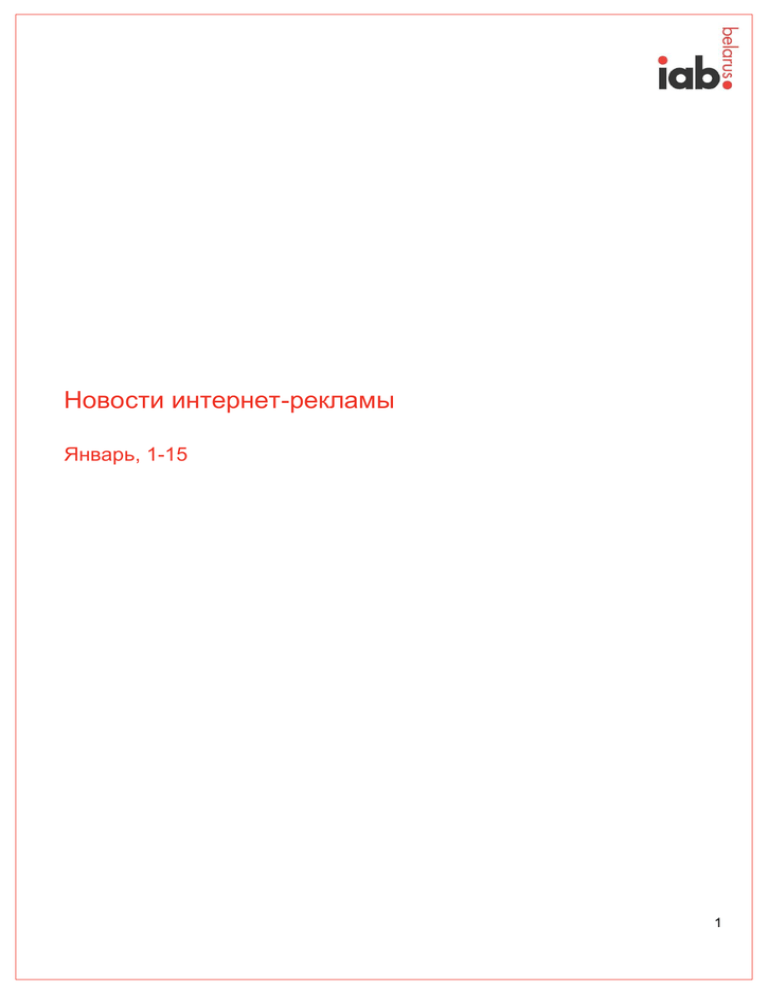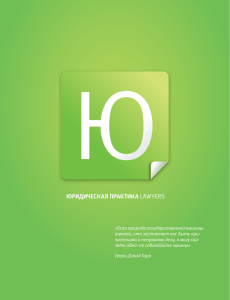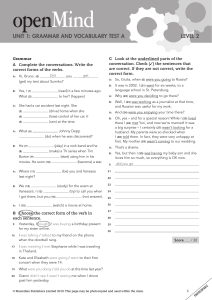Январь, 1-15 1
advertisement

Новости интернет-рекламы Январь, 1-15 1 Содержание Аналитика и интервью…………………………………………………………..……...3 Нативная реклама……………………………………………………….…………...…5 Видеореклама………………………………………………………………………...…7 Mobile……………………………………………………………………………………...8 Programmatic…….……………………………………………………………………...13 Социальные сети…...…………………………….……………………………………14 Новости IAB Global.………………………….…..……………..………………...……20 2 АНАЛИТИКА И ИНТЕРВЬЮ…………………………………………………………… Контекстная реклама уступает медийной на главном рынке Свой прогноз по рынку интернет-рекламы в 2016 году представила компания eMarketer Источник: http://www.sostav.ru/publication/kontekstnaya-reklama-ustupaet-medijnoj-na-glavnom-rynke-20567.html В 2016 году расходы на медийную рекламу в США превысят продажи контекстных объявлений, к такому выводу пришли аналитики компании eMarketer. По их оценкам, в текущем году затраты на медийную рекламу составят 32,17 млрд долларов, против 29,24 млрд долларов - на контекстную. Один из пяти рекламных долларов пойдёт на баннеры и другие медийные форматы, включая нативную рекламу в социальных сетях, расходы на которую в 2016 году достигнут 13,39 млрд долларов, тогда как в прошлом году этот показатель составил 11,57 млрд долларов. Расходы на видео в 2016 году также вырастут и достигнут 9,59 млрд долларов, в прошлом году эта цифра составляла лишь 7,46 млрд долларов. Доля видео в интернет-рекламе увеличится с 12,8% в 2015 до 14,3% в 2016 году. Оставшаяся доля расходов на медийную рекламу будет приходиться на объявления формата rich media и спонсированные публикации брендов. Основная доля расходов по видеорекламе в интернете придется на десктопную рекламу – 57,5%. При этом основная доля расходов на баннеры, рекламные объявления rich media, спонсированные публикации и другие медийные форматы будет сосредоточена на мобильных устройствах – 77,5%. Медиапотребление в России выросло за счет интернета Аутсайдером последних лет среди потребителей ожидаемо стала пресса. Источник: http://www.sostav.ru/publication/mediapotreblenie-v-rossii-vyroslo-za-schet-interneta-20587.html За последние три года россияне стали активнее пользоваться интернетом (на 61%), электронными книгами (31%) и видеоиграми (10%), чаще ходить в кино (на 7%), в театр и на концерты (3%). В целом индекс медиапотребления в 2012–2015 годах вырос на 8%. Аутсайдерами оказались традиционные СМИ: смотрение ТВ снизилось на 5%, потребление радио сократилось на 7%, печатных книг — на 9%, печатных изданий — сразу на 17%. Такие данные приводит «Коммерсантъ» со ссылкой на компанию Deloitte & Touche. 3 Экономическая и политическая ситуация сделали новости самым популярным видом контента у россиян. С помощью телевизора респонденты узнают новости в среднем 4,7 раза в неделю, в интернете — 4,3 раза. Наиболее популярными онлайн-площадками для получения новостей являются личная почта, социальные сети и мессенджеры. Печатными СМИ в этих же целях респонденты пользуются 3,5 раза в неделю, слушают радио — 2,4 раза. Самым полезным медиа российские пользователи считают интернет — такого мнения придерживаются около половины респондентов. Просмотр телевидения полезным находят только 10%. При этом потребители теле- и радиоконтента более отрицательно относятся к рекламе, чем аудитория печатных изданий и активные интернет-пользователи. В среднем пользователи считают онлайн-рекламу полезнее радиорекламы. Особенно заметные потери ТВ несет в сегменте 16–24 лет. Для молодых людей характерно смотрение контента в интернете после того, как они увидели его на телевидении, а также смотрение в пассивном режиме. Выбирать просматриваемый контент склонны люди старшего поколения. Кроме того, 88% респондентов от 16 до 19 лет стали чаще читать электронные книги, что исследователи объясняют более активным образом жизни этой возрастной категории. Индекс медиапотребления основан на разнице между долями опрошенных, отметивших рост и снижение потребления медиа; в онлайн-опросе участвовали 1600 человек старше 16 лет в 46 субъектах РФ. Рынок интернет-рекламы Украины 2015 Источник: http://marketing.rbc.ua/news/16.12.2015/7955 Рынок онлайн-рекламы в Украине демонстрирует стабильный рост, который в 2015 году достиг 11,3%. Общий объем рекламных бюджетов в текущем году составил 2,355 млрд грн, сообщает Всеукраинская рекламная ассоциация (ВРК). Самым крупным сегментом онлайн-рекламы стал поиск — рекламодатели потратили на продвижение в поисковых системах 880 млн грн. По мнению экспертов ВРК, в следующем году рост составит 13%, а объем рынка достигнет 990 млн. Баннерная реклама, объявления в соцсетях, rich media (интерактивная реклама, включающая видео, аудио и другие элементы) привлекли 680 млн со стороны рекламодателей. В следующем году, рост этого сегмента будет незначительным и составит 4%. Сегмент спонсорства составил 120 млн грн, а на 2016 год эксперты прогнозируют рост на треть до 160 млн грн. 4 Мобильная реклама в следующем году также вырастет на треть до 200 млн. В 2015 году бюджеты на нее составили 150 млн. Максимальный рост в 2015 и 2016 прогнозируют для цифрового видео, в том числе благодаря YouTube составляющей, а также ожидаемому применению аукционов. Он составил около 40%. Эксперты ВРК предполагают, что первая половина 2016 будет адаптацией к новым правилам закупок видео (аукционам), а также прогнозируют, что вторая половина 2016 года может показать еще более динамичный рост. Объем рынка онлайн-видеорекламы составил в 2015 году 325 млн грн, а в 2016 прогнозируется на уровне 455 млн грн. На другие digital-инструменты рекламы в 2015 году пришлось 200 млн грн рекламных бюджетов. Рост затрат на них в следующем году прогнозируется на уровне 15%. Доля агентского рынка в категориях существенно отличается. От минимальной в поиске (порядка 15%) до максимальной в видео и другом digital (порядка 90–95%). По словам экспертов, причины такого роста не только в повышенном интересе к интернету как медиаканалу со стороны рекламодателей, но и следствие девальвации, так как практически все категории интернетносителей содержат валютную составляющую. НАТИВНАЯ РЕКЛАМА…………………………………………………………………… Ad Blocking Will Push Native Advertising Ahead in 2016 - See more at: http://www.emarketer.com/Article/Ad-Blocking-Will-Push-Native-Advertising-Ahead2016/1013437?ecid=NL1010#sthash.CBKta875.dpuf Justin Choi, founder and CEO of native advertising platform Nativo, recently spoke with eMarketer’s Lauren Fisher about the future of native advertising, particularly its growing popularity thanks to issues of ad quality and ad blocking. He also shared his predictions for programmatic’s influence on this ad format in 2016.0 eMarketer: What trends do you expect to see in native advertising in 2016? Justin Choi: Native began to get a ton of attention in the second half of 2015 thanks to the importance of many other digital trends, everything from ad fraud and viewability to ad blocking. Our advertisers are actually starting to use words like “customer experience” and being really mindful of ad executions that are less interruptive and more engagement-oriented. 5 With all of these issues, particularly ad blocking, any technical workaround is not going to be a long-term solution if the quality of the advertising experience is poor. So if native becomes an irritable form of advertising, if any advertising becomes irritable and delivers a bad experience, there’s going to be an ad block for it. eMarketer: With native poised to take off in 2016, do you foresee the potential for native to evolve into an advertising experience that could be considered irritating? In the past, when the industry has moved to a new format, there has been a push to jam and cram ads to try and get volume. Do you foresee this issue happening with native? Choi: We foresee it being a pressure. Eventually, we do see the whole advertising industry having some type of native offering. Whether it’s truly native or not, they’re going to have some kind of ad that’s in the feed. And you’re right, that’s the fear, that native will go on a downward spiral once everyone jams into that position. And then you will have some players that won’t deliver or aren’t mindful of the user experiences or long-term viability of a publisher. But I think the difference this time is that the publishers are smarter about it. And advertisers are now on board with wanting to deliver good user experiences to consumers. That’s one of the positives around ad blocking: People are starting to pay attention to quality. But when I say “user experiences” I don’t just mean ad blocking—I mean things like ad load speeds and site performance that people haven’t been mindful of. eMarketer: What other trends are you seeing? Choi: One is native video. Native and video are often separated into two buckets. But this year, in-feed video will become a big focal point, largely driven by Facebook. And I think people will start to realize that native is a placement and video a form of content, and that the two actually work together. eMarketer: It’s hard to ignore the momentum behind Facebook’s in-feed video. But what about the rest of the publishing community? Are they looking to migrate to native with video in mind? Choi: Right now, they’re at risk of getting caught flatfooted, and Facebook is taking a huge chunk of the dollars before publishers really get up and going. It’s not that publishers don’t have the capability now, but we’re finding they’re not moving as quickly as they could to get ahead of the trend here. eMarketer: One thing we’re excited about is native programmatic for 2016. Any specific predictions here? Choi: What we’re seeing is a desire to aggregate or to automate some of the native relationships they have across different publishers. Even though native is starting to scale, for advertisers, it’s still a very one-to-one relationship with publishers. There are some companies out there saying there is programmatic native, but the reality is that it hasn’t taken off yet. But what we’re seeing from the brand side is they’re actually starting to try and automate those relationships with 6 publishers. But they’re not just looking for pure ad-tech-type solutions. They want solutions that are more programmatic content-focused. So one of the predictions that we’re making for 2016 is that from a brand perspective, programmatic native isn’t the trend, programmatic content is. Native just happens to be the placement, and programmatic is the way to scale those efforts around content across device. Content is a way to engage customers in a much more meaningful manner than just plopping ads in front of them. That’s why video is a huge part of the content strategy. And as far as where video content was typically thought of for television, we think that with the ability to scale and with native placements, the brands that will invest in content will also invest heavily in video content and look to scale that across different placements. That’s why in 2016, I predict we’ll start to see the days of video living across different screens and a siloed buy going away. ВИДЕОРЕКЛАМА………………………………………………………………………… Крупнейший в мире онлайн-кинотеатр начал работу в России Стриминговый сервис Netflix запустился в 130 странах одновременно Источник: http://www.sostav.ru/publication/krupnejshij-v-mire-onlajn-kinoteatr-nachal-rabotu-v-rossii-20522.html Крупнейший онлайн-кинотеатр Netflix теперь доступен практически по всему миру. 6 января видеосервис объявил о масштабном запуске в 130 странах, включая Россию. «Сегодня вы стали свидетелями рождения новой глобальной сети интернет-телевидения», — заявил сооснователь и глава компании Рид Хастингс на выставке CES 2016 в Лас-Вегасе. Исключением для Netflix стал материковый Китай, однако сервис не оставит попыток получить разрешения властей и выйти на этот перспективный рынок. Компания также не будет работать в регионах, которые находятся под санкциями США. Это значит, что посмотреть сериалы и телешоу не смогут жители Крыма, Северной Корее и Сирии. Зато Netflix добавил 17 новых языков, в том числе корейский, арабский и китайский. В настоящее время российская версия Netflix доступна только на английском языке. Новым пользователям предлагается бесплатный месяц просмотра, а также три варианта подписки: базовый, стандартный и премиум. Самый дешевый тариф — 7,99 евро, около 650 рублей — позволяет смотреть видео на одном экране в стандартном разрешении. За 9,99 евро добавляется второй экран и возможность смотреть в HD, за 11,99 евро контент доступен на 4 экранах, добавляется функция Ultra HD. Пока российский каталог довольно скромен: 727 наименований, из них 527 фильмов и 200 сериалов. Для сравнения: жителям США доступно 5739 наименований (4588 фильмов и 1151 сериал). Часть контента уже 7 имеет русские субтитры и озвучку, однако многие фильмы оказались недоступны пользователям из России, ранее зарегистрировавшимся в Netflix и смотревшим видео через VPN. Например, отсутствуют «Карточный домик» и один сезон «Ганнибала». Это связано с тем, что эксклюзивные права на показ некоторых сериалов приобрели местные игроки (например, «Амедиатека»). Netflix создан в 1997 году как прокатчик DVD-дисков. Компания доставляла фильмы по почте, а когда количество заказов достигло 100 тысяч в день, руководство решило разрабатывать новую систему доставки. В 2007 году был запущен стриминговый сервис, который начал продаыать видео по запросу (video-ondemand, VOD). Позже компания занялась производством собственного контента. До сих пор Netflix работал в 60 странах мира. По данным компании, более 70 млн человек просматривают более 100 млн часов сериалов и кинофильмов ежедневно. В 2014 году выручка Netflix составила 5,5 млрд долларов, чистая прибыль — 266,8 млн долларов. Капитализация компании на бирже NASDAQ превышает 46 млрд долларов. MOBILE………………...……………………………..……………………………………. Mobile Video Ads Drive Brand Awareness, Engagement Digital video ad spending is growing - See more at: http://www.emarketer.com/Article/Mobile-Video-Ads-Drive-Brand-AwarenessEngagement/1013464?ecid=NL1002#sthash.r6DddK4j.dpuf Mobile video advertising brings a lot of value to marketers, primarily increasing brand awareness. It also helps with lead generation and better engagement, according to a December 2015 survey. Trusted Media Brands (TMB) and Advertiser Perceptions asked US media decision-makers to choose their top three benefits of mobile video ads—whether or not they currently use them. Almost half of respondents (47%) said that increasing brand awareness was one of their primary benefits and a little over a third said that better engagement and interaction was. 8 Additionally, nearly one-third of respondents said that mobile video ads were suited to mobile consumption behaviors. 9 That mobile video ads get higher clickthrough than desktop-based ads and are less intrusive also appealed to media decision-makers, but lower on the list. Mobile video ad spending is growing faster than any other digital advertising format in the US, according to eMarketer estimates. Spending on mobile video advertising will grow more than 70% to reach $2.62 billion in 2015—over one-third of the estimated $7.77 billion to be spent on digital video ads. By 2019, eMarketer estimates, mobile’s share of total digital video ad dollars will reach 47.7%. Study: As Smartphone Use Increases, Are You Wasting Money on TV Ads? http://www.adweek.com/socialtimes/study-as-smartphone-use-increases-are-you-wasting-money-on-tv-ads/632319 Most likely, the television is no longer the dominant screen in your target audience’s household. A comprehensive new study by Yahoo Advertising finds that not only is mobile use on the rise (while TV is declining), but mobile ads achieve a more emotional response than traditional television spots. Yahoo found that in 2015, 53 percent of mobile phone users all over the world were mobile internet users — the first time that mark has risen above 50 percent. Nearly 3 out of 5 people in the U.S. used a smartphone to access the internet, and smartphone adoption rates in the U.S. are growing by 11.4 percent (now at 190.5 million). However, Yahoo cited an eMarketer study, showing that the average daily time spent on mobile has grown 47 percent (from 2:15 to 3:18), computer has dipped 4 percent and television has declined 12 percent. Yet, TV still outpaces digital on ad spend, 41 percent to 34 percent. An increasing amount of people are using smartphones (and laptops) as they’re watching TV. Citing Nielsen, Yahoo found that both Gen X’ers and Millennials cop to using at least a laptop while watching television, and a scant few said they multitask on all three devices — smartphone, laptop and TV. Both Millennials and Gen X’ers tended to multitask more during primetime TV (7 p.m. to 10 p.m.), with Millennials switching devices 8.7 times per hour and Gen X’ers switching devices 9.2 times per hour. The study showed some interesting differences in how these two age groups are served ads and how they react to them. Overall, Yahoo found that mobile ads achieve a more emotional response than television commercials. Yahoo finds that the most ad-bombarded group (Millennials) are also the people most responsive to advertising. 10 11 Yahoo found that advertising during primetime actually makes people more responsive to ads. Among Millennials, Yahoo saw a 13 percent lift in emotional response to mobile ads among multitaskers (this figure was 6 percent for Gen X multitaskers). Even though the television is the most-watched screen, many people are paying more attention to their computer or phone as the show plays. The Yahoo study summed up what marketers need to know about reaching these multitaskers: Mobile apps continue to grow media influence on mobile. When targeting these key segments, keep in mind the unique opportunities every demographic presents. Content is king. As phablet penetration increases expect this to alter behavior considerably among younger demographics. Mobile Banner Ads To Drop In Popularity, Native And Video Ads Gain Momentum http://www.mediapost.com/publications/article/266093/mobile-banner-ads-to-drop-in-popularity-native-an.html Banner display ads will no longer be the format of choice for many mobile advertisers and marketers in 2016, a study from Trusted Media Brands , Inc. has found. The survey of clients and agency executives, released Wednesday, was conducted by Advertiser Perceptions. Although display ads -- including banners -- saw immense growth in the third quarter of last year (mobile accounted for 55% of all display ad clicks in the third quarter), many consumers and advertisers feel their interruptive nature may do more harm than good. According to the survey, 63% of respondents used display banners in 2015, while this year only 45% expect to do so. Video and native ads are considered to be less interruptive to mobile user experience and better at lifting brand awareness and engagement. Some 45% of respondents expect to use video in 2016, with 46% planning to use preor mid-roll. Forty-five percent of respondents plan to use native ads in mobile, down from 50% last year. Among the major benefits of native and video ads, the survey found they are perceived to be less intrusive, increase brand awareness, and foster better engagement and interaction. As more video formats in addition to pre and midroll become available and reliable, mobile video will most likely become an even more highly desirable format, commanding high CPMs. In October, eMarketer noted that both video and display were well positioned to help mobile programmatic spending take off this year, and maintain its ascendancy through 2017. 12 Formerly known as Reader’s Digest, Trusted Media Brands, Inc. is the umbrella underneath which publications like Taste of Home, Family Handyman and Reader’s Digest now reside. PROGRAMMATIC……………………………..………………………………………….. What's Important When Buying Programmatically? The ability to buy rich media and video in-stream is significant - See more at: http://www.emarketer.com/Article/Whats-Important-BuyingProgrammatically/1013414?ecid=NL1010#sthash.npcdRyLg.dpuf When buying programmatically, there are many important factors that come into play. Being able to buy display, as well as inventory across channels via a single platform, are two of the top ones, according to US media practitioners. More than two-thirds of US agency, media and marketing professionals said the ability to buy display and the ability to buy inventory across channels like mobile and desktop via a single platform were important factors when buying programmatically, according to an October 2015 survey from Advertising Age and RhythmOne. Ratings of 8 to 10 on a scale of 1 to 10, where one is “not at all important” and 10 is “extremely important,” were considered “important.” 13 The ability to buy rich media, in-stream video and native ads were also important to more than half of respondents. While offerings of inventory from digital out-of-home, via connected TV or from wearables were also important when buying programmatically, these factors ranked lower on the list. US programmatic digital video ad spending reached $2.91 billion in 2015, accounting for 39% of 2015’s total US digital video ad spend. Overall, enthusiasm for automating the procurement of digital video ads remains high, but investment trails in comparison to the broader digital display market. eMarketer forecast that 59% of the $26.15 billion spent on US digital display ads in 2015 would be transacted programmatically, but just 39% of US digital video ad dollars were spent that way. By 2017, however, that portion will move closer to the broader average for programmatic activity (72%), accounting for 65%, or $7.43 billion. СOЦИАЛЬНЫЕ СЕТИ…………………………………………………………………… Сколько зарабатывают соцмедиа в России Темпы роста отечественного рынка рекламы в соцсетях втрое ниже общемировых Источник: http://www.sostav.ru/publication/skolko-zarabatyvayut-sotsseti-v-rossii-20570.html 14 Российский рынок социальных медиа активно развивается вместе с проникновением интернета и мобильных технологий в самые дальние уголки нашей страны. Растут и рекламные доходы, причем темпами, сравнимыми с самыми передовыми каналами медийной коммуникации. Но кризис влияет и на эту сферу отечественного рекламного рынка: на глобальном рынке рост рекламных доходов соцсетей происходит втрое быстрее. Рекламные доходы на российском рынке социальных медиа в 2015 году сохранили двузначные темпы роста: согласно оценке РАЭК, прирост к 2014 году составил 15%, и достиг отметки в 8,5 млрд. рублей. Несмотря на кризисные реалии, соцсети в России смогли заработать на 1,1 млрд рублей больше, чем годом ранее, констатируют эксперты. При этом темпы роста рекламных доходов соцсетей в России значительно отстают от ведущих мировых рынков: согласно оценке агентства Initiative на основе данных Magna Global, рынок социальных медиа в Великобритании за 2015 год прибавил по рекламным доходам 45% по отношению к 2014 году (1,3 млрд долларов). Глобальный рынок рекламы в соцмедиа по итогам 2015 года вырос на 44%, и достиг отметки в 23,7 млрд долларов. Таким образом, исходя из средневзвешенного курса рубля к доллару на IV квартал 2015 года, рекламные доходы соцмедиа в России равнялись в минувшем году порядка 117 млн долларов, что составляет менее полупроцента от объемов глобального рынка. Наибольшие затраты на рекламу в социальных сетях на российском рынка у таких категорий, как FMCG, телекоммуникации, электронная техника (ADV-SocialCraft). Лидером по аудитории и рекламным доходам среди социальных медиа в России остается "ВКонтакте", принадлежащая холдингу Mail.ru Group. Согласно финансовому отчету холдинга за III квартал 2015 года, рост выручки флагманской соцсети составил 55,4% и достиг отметки в 1,5 млрд рублей. За 9 месяцев 2015 года рост составил 41,2%. Таким образом, "ВКонтакте" является основным генератором рекламных доходов Mail.ru Group - на соцсеть приходится не менее 40% от общего объема. Отмечается, что одним из основных драйверов роста доходов соцсети стал запуск в нативной рекламы (промо-постов). Эксперты Initiative высоко отметили темпы роста рекламных доходов в социальном фотосервисе Instagram, который запустил в сентябре прошлого года продажи рекламы на российском рынке. Растут рекламные бюджеты на сотрудничество с блогерами и селебрити. Самыми перспективными из новых соцмедиа эксперты называют Periscope - сервис, который бренды на развитых рынках уже активно используют для маркетингового продвижения, и в особенности для трансляции событий и мероприятий. 15 Также к перспективным соцмедиа относят мессенджер Telegram: для рекламодателей в данном сервисе в первую очередь интересны возможности создания публичных каналов и ботов. CTR в Facebook вырос на 17% Источник: http://marketing.by/novosti-rynka/ctr-v-facebook-vyros-na-17/ Компания Nanigans, занимающаяся автоматизацией покупки рекламы, опубликовала отчет о работе рекламы в Facebook в четвертом квартале 2015 года. Рекламные бюджеты продолжают расти. По сравнению с III кварталом 2015 года затраты на рекламу в Facebook в IV квартале выросли на 16%. Особенно отличились онлайн-ритейлеры: средний чек заказа вырос на 49%, а показатель ROAS (возврат инвестированных в рекламу финансов) — на 87%. Также рекламодатели увеличили расходы на видео. Популярность видеорекламы растет среди перфомансмаркетологов, особенно в мобайле и за пределами США. Средние траты на видео увеличились на 41% по сравнению с III кварталом 2015 года, вне Америки — на 86%. Расходы на мобильное видео выросли на 44%, за пределами США эта тенденция сохраняется – 94%. Рекламодатели увидели преимущества формата DPA (Dinamic Product AD), использование этого персонализированного инструмента в режиме реального времени выросло на 210% в IV квартале 2015 года. Формат «кольцевая галерея» (демонстрация 3–5 изображений и ссылок в одном рекламном объявлении) показал рост еще в III квартале 2015 года. И этот тренд продолжился и в исследуемый период. Его использование увеличилось на 34%. По данным Nanigans, CTR в Facebook вырос на 17%. Это свидетельствует о том, что пользователи интересуются рекламой и взаимодействуют с ней. Исследование позволяет проследить динамику показателя 16 с 2013 года: рост CTR в среднем в год составляет 62%. Что касается электронной коммерции, CTR в этом сегменте растет не так быстро – всего 1,06%. Для игровых компаний CTR увеличился на 24%. Одним из решающих факторов стало большое количество видеорекламы — этот формат традиционно собирает больше кликов, чем статичное объявление. Показатель CPC (cost per click — цена за клик) остается относительно стабильным. Но по сравнению с тем же периодом в 2014 году CPC снизился на 11% и составляет $0,57. Что касается электронной коммерции, там цифры немного больше, а именно $0,69, CPC ожидаемо показал рост на 21% в праздничный период, 17 хотя и не такой, как в прошлом году – 29% роста в IV квартале 2014 года ($0,63). В игровом секторе CPC упал на 19% ($0,61). CPM (cost per 1000 impressions — цена за 1000 контактов) вырос на 24% за последнюю четверть, за год рост этого показателя составил 62%. В электронной коммерции показатель CPM – $7,35, что на 33% больше, чем в предыдущей четверти, и на 49% в IV квартале 2014 года. Nanigans проанализировали данные по трем разным регионам: Америка; Европа, Средний Восток и Африка; Азиатско-Тихоокеанский регион. 18 19 НОВОСТИ IAB GLOBAL………………………………………………………………. Обзор исследований IAB Global за 2015г. Все исследовательские отчеты можно скачать здесь: http://www.iab.com/insights/2014-2015-iab-research-hub/ IAB Research Council: 2015 in Review http://www.iab.com/news/iab-research-council-2015-in-review/ Digital ad revenue has grown annually by double-digits surpassing $50 Billion in 2015, all the while accompanied by change. 2015 saw the continued transformation of the digital advertising industry and the IAB Research Council and its working groups were on the front lines of that transformation, proactively planning and nimbly reacting to those changes and how they affect the way we do business. Throughout the year, the IAB Research Council has continued its focus on research quality of the underlying measurement tools that underpin these transformations. In addition to having commenced an innovative, industry wide Cross Media Ad Effectiveness Study, the Research Council has also formed several Working Groups to act as forums to discuss key issues around digital measurement and to explore ways in which measurement, reporting and data can be improved. In 2015, the Research Council broke ground on its own Cross Platform Ad Effectiveness Study co-sponsored by Drawbridge, Discovery and Yume which measures the impact that digital and mobile media has on a traditional media campaign. The research uses innovative techniques to try to discern the incremental brand lift of digital and mobile advertising in conjunction with media formats like TV, print and out of home. IAB member companies that are interested in co-sponsoring the study can contact Kristina Sruoginis at Kristina@IAB.com. In response to the rising importance of getting cross platform measurement right, the IAB Research Council formed the Working Group to Discuss Cross Platform Measurement Issues. The working group met to discuss the issues around existing proposed solutions and to discuss the potential problems with any upcoming solutions. The key focus was on what can be done to make cross-platform measurement more comparable across all platforms. The group eagerly awaits the further development of new cross platform measurement tools and vendor initiatives. Vendors will be brought in to present and discuss their cross platform measurement solutions with the Research Council and the working group in early 2016. Similarly, the Research Council reconvened the Working Group to Update the Best Practices for Ad Effectiveness Studies to discuss what has changed since the research and working group documents were first completed a few years ago and what issues still remain relevant today. The group will continue its discussions in 2016. 20 As a result of an active discussion that took place around the topic of data quality at a Research Council meeting, the Research Council Data Measurement Working Group met to revisit the document it had released in early 2015 called Data Segments: Looking Under the Hood and to further discuss data measurement issues. The document illustrates the many options and complexities involved in the underlying data sources that form commonly used data segments like ‘auto intenders’ and sheds light on the many points where data could be misinterpreted and quality compromised. The working group will meet again in 2016 to review research work on data quality. In addition to the work that the IAB Research Council has done over the year on these topics, the IAB has also created and released numerous research studies over 2015 independently of the Research Council to provide insights and thought leadership to our members and the industry on these trends and changes in the digital advertising industry. Key studies explore transformative topics ranging from the rise of programmatic buying to the promise of advanced TV to the adoption of new ad formats like Rising Stars ads (and their brand impact) to the continued growth of video and mobile usage and the threats of ad blocking and an untrustworthy supply chain. An example of this is the transformation of TV and video. TV is no longer a standalone experience: 78% of US adults multiscreen, or watch TV while online on a computer, tablet or smartphone, as revealed in the IAB study The Changing TV Experience. Consumers are increasingly dividing their TV screen time with streamed digital video and Original Digital Video is considered by its viewers to be on par with some forms of TV content, as revealed in the 2015 Original Digital Video Consumer Study. This study along with two more IAB studies measuring buyers’ perspectives on the video format, 2015 Original Digital Video Ad Spend Benchmark and Content Revelations (in collaboration with Digitas), released at the IAB NewFronts illustrate the growing importance that cross platform measurement tools will play in the ever-evolving ecosystem. This point was further emphasized with original video and connected TV research presented at the IAB NewFronts Insights Lunch, a well-attended event now in its third year that continues to garner press attention. As part of the NewFronts, the luncheon provided a forum for new video research to be unveiled. Five member companies of the IAB Research Council were selected to showcase their studies to an attentive crowd of buyers and press. About the author Kristina Sruoginis Kristina Sruoginis is a Research Director at IAB 21



